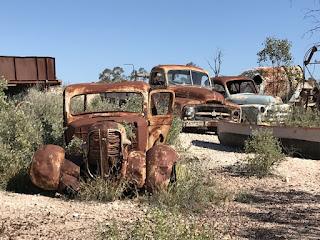I’ve always wanted to see Lightning Ridge. The town’s iconic status as an Outback frontier is almost mythical. It’s one of Australia’s best-known opal mining regions, alongside Cooper Pedy and White Cliffs. However, unlike its famous subterranean peers, Lightning Ridge is built entirely above ground. Apparently, the area’s geography isn’t suitable for excavating large, stable caverns.
We tried every tour route and made the most of their various stops along the way. Highlights included a self guided tour through the Walk In Mine (a discontinued Black Opal mine), Bevan’s Cactus Nursery, and a wander around the rather eclectic, Amigo's Castle.
However, the most photogenic highlight has to be the Corrugated Iron Church we visited on the Yellow Car Door tour. This rustic structure was built in 2000 as a film set for the movie "Goddess of 1967". The movie tells the story of a wealthy young Japanese man who comes to Australia to buy a Citroen (The Goddess). He ends up going on an outback tour reliving a dark past with his travelling companion.
We also visited a second mine near the local airport. The Big Opal mine is accessed via 130 steps descending a spiral staircase. Once underground a guide map leads you through rough hued rock tunnels dotted with nocks and crannies and rusting artefacts. If you look carefully, you can even see a couple of opal seams snaking along the walls and ceiling.
They say a visit to Lightning Ridge isn’t complete without a dip in the steaming waters of the local Artesian Bore Baths. It’s an extraordinary experience. The hot water in the baths comes from the local artesian bore supplying the township’s water. The water is naturally heated deep underground resulting in a constant bathing temperature between 40 to 50 degrees Celsius all year round.
We also visited a second mine near the local airport. The Big Opal mine is accessed via 130 steps descending a spiral staircase. Once underground a guide map leads you through rough hued rock tunnels dotted with nocks and crannies and rusting artefacts. If you look carefully, you can even see a couple of opal seams snaking along the walls and ceiling.
They say a visit to Lightning Ridge isn’t complete without a dip in the steaming waters of the local Artesian Bore Baths. It’s an extraordinary experience. The hot water in the baths comes from the local artesian bore supplying the township’s water. The water is naturally heated deep underground resulting in a constant bathing temperature between 40 to 50 degrees Celsius all year round.
We gingerly eased ourselves into steaming water for a relaxing soak. Although, within 15 minutes or so we both found the heat too much to bear. Our artesian experience almost didn’t happen. A few days earlier, we realised we’d forgotten to pack any swimmers. However, our momentary crisis was averted by a quick dash to K-Mart Tamworth to buy a discounted pair.
Our trip to Lightning Ridge also gave us an opportunity to see firsthand the work of John Murray, a popular local artist. He paints stunning, and often quirky, images of the Australian Outback. We currently have one of his prints on display in the boardroom of our new office. It attracts plenty of accolades from visitors. Around Lightning Ridge, we saw several murals painted by John Murray including a rather humorous example depicting a flock of emus raiding lingerie on a clothesline.
We made one final stop during our time in Lightning Ridge. On our way out of town, we stopped to admire a towering metallic sculpture affectionately known as Stanley the Emu. It's made entirely from recycled materials including the body of Volkswagon Bettle.
UPDATE: 18 December 2020
Lightning Ridge locals report that the corrugated iron church was destroyed in a freak storm this week. The structure was built largely from MDF and other temporary materials so its collapse was bound to happen at some point. It looks like Garry and I were lucky enough to see it before it was gone.

















No comments:
Post a Comment